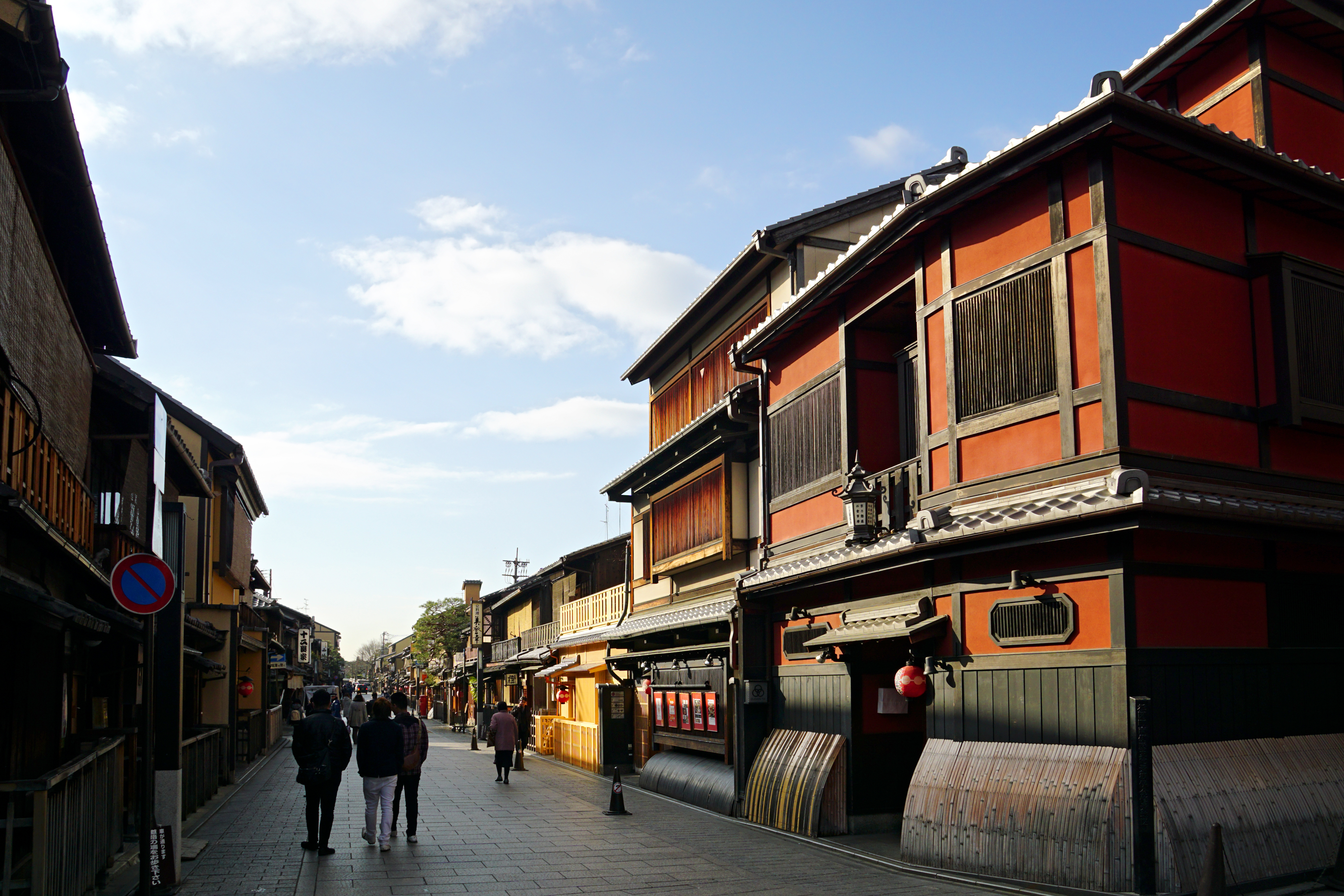|
Hanamachi
A is a district where geisha live and work in Japan. Each typically has its own name, crest, and distinct geisha population, with geisha not typically working outside of their own district. usually contain (geisha houses) and (teahouses where geisha entertain). Historically, could contain a high number of and , and would also contain a as well – a communal meeting place for geisha, typically containing a theater, rooms where classes in the traditional arts could be held, and a (registry office) who would process a geisha's pay, regulation of the profession, and other related matters. Gion, a geisha district in Kyoto, also has a vocational school, called . Many of the teachers there are designated as Living National Treasures. were preceded by the registered red-light districts of Japan, known as . Three were established in Japan in the early 1600s: Shimabara in Kyoto in 1640,Avery, Anne Louise. ''Flowers of the Floating World: Geisha and Courtesans in Japanes ... [...More Info...] [...Related Items...] OR: [Wikipedia] [Google] [Baidu] |
Kamishichiken
, pronounced locally as Kamihichiken, is a district of northwest Kyoto, Japan. It is the oldest hanamachi (geisha district) in Kyoto, and is located just east of the Kitano Tenman-gū shrine. The name Kamishichiken literally means "Seven Upper Houses". These refer to the seven teahouses built from the equipment and material left over from the rebuilding of the Kitano Shrine in the Muromachi era (1333–1573). Kamishichiken is located in Kyoto's Nishijin area, which is known for traditional hand-woven textiles. The quiet streets of Kamigyō-ku are made up of dark wooden buildings, mainly (teahouses) and (geisha houses). Unlike the other remaining districts, which are located close to the city center, Kamishichiken is further away, and accordingly significantly quieter and attracts fewer tourists. The geisha of this district are known for being subtle and demure, few in number but each highly accomplished dancers and musicians. There are approximately 25 (apprentice geisha) and ge ... [...More Info...] [...Related Items...] OR: [Wikipedia] [Google] [Baidu] |
Geisha
{{Culture of Japan, Traditions, Geisha {{nihongo, Geisha{{efn, {{IPAc-en, lang, ˈ, ɡ, eɪ, ., ʃ, ə, {{IPA, ja, ɡei.ɕa, ɡeː-, lang{{cite book, script-title=ja:NHK日本語発音アクセント新辞典, publisher=NHK Publishing, editor=NHK Broadcasting Culture Research Institute, date=24 May 2016, lang=ja, 芸者, also known as {{nihongo, , 芸子, geiko{{efn, {{IPA, ja, ɡei.ko, ɡeː-, lang, {{citation needed span, in Kyoto and Kanazawa, date=May 2025 or {{nihongo, , 芸妓, geigi{{efn, {{IPA, ja, ɡeꜜi.ɡi, ɡeꜜː-, -ŋi, lang , are female Japanese people, Japanese performing arts, performing artists and entertainers trained in performing arts#Japan, traditional Japanese performing arts styles, such as Japanese traditional dance, dance, Music of Japan, music and singing, as well as being proficient conversationalists and hosts. Their distinct appearance is characterised by long, trailing kimono, nihongami#geisha, traditional hairstyles and {{transliteration, ja, o ... [...More Info...] [...Related Items...] OR: [Wikipedia] [Google] [Baidu] |
Miyagawa-chō
is one of the or geisha districts in Kyoto. means "Shrine River", referring to the nickname of the Kamo River just south of Shijō. During the Gion Matsuri, Gion Festival the (divine palanquin) of Yasaka Shrine used to be purified in the waters of this river. Miyagawa-chō trademark consists of three interlocked rings, symbolizing the unity of the shrine/temples, the townspeople, and the teahouses. What is now Miyagawa-chō was a place where entertainers gathered. Kabuki was performed in many small theaters on the banks of the Kamo River. Some of the Japanese tea ceremony, teahouses were even boats that operated in the river. As kabuki was just then developing into a mass entertainment spectacle as known today, the area was very popular and Miyagawa-chō quickly grew into a full town of teahouses. The association with kabuki has gone, but the Minami-za kabuki theatre of Kyoto still stands on its historical spot on the east bank of the Kamo River. Today, Miyagawa-chō has its ... [...More Info...] [...Related Items...] OR: [Wikipedia] [Google] [Baidu] |
Ochaya
In Japan, an is an establishment where patrons are entertained by geisha. In the Edo period, ''chaya'' could refer to establishments serving tea and drinks (), offering rooms for rent by the hour (), or brothels ( in Osaka, in Edo). However, in the modern day, refers exclusively to the establishments within Kyoto in which geisha work and entertain their clients, though the term is sometimes used to describe all establishments used by geisha to entertain guests, irrespective of location. Equivalent establishments in locations outside of Kyoto are known as , meaning "restaurant", referring to a traditional Japanese-style restaurant where geisha may entertain. Terminology Though the term literally means "tea house", the term follows the naming conventions of buildings or rooms used for Japanese tea ceremony, known as ; as such, though tea is served at as an ordinary beverage, it is not, unlike teahouses and tearooms found throughout the world, its sole purpose. When used as ... [...More Info...] [...Related Items...] OR: [Wikipedia] [Google] [Baidu] |
Gion
is a district of Higashiyama-ku, Kyoto, Japan, originating as an entertainment district in the Sengoku period, in front of Yasaka Shrine (Gion Shrine). The district was built to accommodate the needs of travellers and visitors to the shrine. It eventually evolved to become one of the most exclusive and well-known geisha districts in all of Japan. Gion is the Japanese translation (via Chinese ''Qiyuan'') of the Buddhist term Jetavana. Yasaka Shrine, located in this district is the center of the Gion faith. The geisha in Kyoto do not refer to themselves as geisha, instead using the local term . While the term geisha means "artist" or "person of the arts", the more direct term means essentially "a woman of art". Divisions Gion houses two , or geisha districts: and . The two were originally the same district, but split many years ago. Gion Kobu is larger, occupying most of the district including the famous Hanamikoji street, while Gion Higashi is smaller and occupies t ... [...More Info...] [...Related Items...] OR: [Wikipedia] [Google] [Baidu] |
Yūkaku
were legal red-light districts in Japanese history, where both brothels and prostitutes Prostitution is a type of sex work that involves engaging in sexual activity in exchange for payment. The definition of "sexual activity" varies, and is often defined as an activity requiring physical contact (e.g., sexual intercourse, non-p ... - known collectively as , the higher ranks of which were known as - recognised by the Japanese government operated. ��郭��大百科事典. 第25巻』 (平凡社, 1939) Though prostitution was, officially, legal to engage in and pay for only in these areas, there were a number of places where prostitutes and brothels operated illegally, known as , the generic name for all unlicensed red-light districts other than Yoshiwara (later including both Shimabara and Shinmachi).平田(1997)109頁。 In January 1946, GHQ issued an order (SCAPIN 642) nationwide to abolish Japan's legalised system of prostitution, with brothels in the areas ha ... [...More Info...] [...Related Items...] OR: [Wikipedia] [Google] [Baidu] |
Kamo River
The is located in Kyoto Prefecture, Japan. The riverbanks are popular walking spots for residents and tourists. In summer, restaurants open balconies looking out to the river. There are walkways running alongside the river, and some stepping stones that cross the river. The water level of the river is usually relatively low; less than one meter in most places. During the East Asian rainy season, rainy season, however, the walkways sometimes flood in their lower stretches. It is known for the two Kamo Shrines on its course: Kamigamo Shrine and Shimogamo Shrine and the shared Chinju no Mori between them Tadasu no Mori, Tadasu-no-mori. Geography The Kamo River has its source in the mountains in the area of Mount Sajikigatake, around the boundary of Kumogahata village and Keihoku village in the Kita-ku, Kyoto, northern ward of Kyoto. Flowing into the Kyoto Basin from the city area called Kamigamo in the same northern ward of the city, from there it bends south-east and, around th ... [...More Info...] [...Related Items...] OR: [Wikipedia] [Google] [Baidu] |
Tayū
were the highest rank of female entertainers in early modern Japanese licensed quarters. were distinguished historically from other courtesans (yūjo; women of pleasure) and entertainers (Maiko, Geisha/Geiko) by their intensive training in numerous traditional artforms from a young age. The prestige this education conferred on them allowed them to refuse clients. They were the only entertainers to attend the Imperial banquets. were known for their training in Japanese tea ceremony, , , Japanese calligraphy, poetry, dance, singing, and the playing of traditional instruments, such as the . History differed from lower ranks of ''oiran'' by the social class of their customers and the services they offer. Traditionally, catered for the uppermost echelons of society, including the nobility and the imperial court. were recognised as a group in the beginning of the Edo period. Due to the limited size of their clientele, they were never numerous; during their peak there were appr ... [...More Info...] [...Related Items...] OR: [Wikipedia] [Google] [Baidu] |
Ponto-chō
is a district in Kyoto, Japan, known for its and , and is home to many of the city's and traditional tea houses. Like Gion, Ponto-chō is famous for the preservation of forms of traditional architecture and entertainment. Etymology The name "Ponto" is believed to come from the Portuguese word (bridge), and is written in kanji used for their sound only (''ateji''). The Japanese word means town, block or street. District Ponto-chō as a district is for the most part constructed around a long, narrow alleyway, running from Shijō-dōri to Sanjō-dōri, one block west of the Kamo River. This location is also known as the traditional location for the beginning of kabuki as an art form, and a statue of kabuki's founder, Izumo no Okuni, stands on the opposite side of the river. The district's crest is a stylized water plover, or . Cultural features ''Geiko'' and have existed in Ponto-chō since at least the 16th century, as have prostitution and other forms of entertainmen ... [...More Info...] [...Related Items...] OR: [Wikipedia] [Google] [Baidu] |
Gojō Street
Gojō Street (五条通 ごじょうどおり ''Gojō dōri'') is a major street that crosses the center of the city of Kyoto from east to west, running from Higashi Ōji Street (east) to Kadononishi Street (west). History During the period of the Heian-kyō, it was a narrow street known as Rokujō Bōmon Kōji (六条坊門小路). The road that was formerly known as Gojō Ōji was actually located where Matsubara Street stands today and for this reason, the bridge now known as Matsubara-bashi supposedly was the Gojō Ōhashi of that time. During World War II, WWII, houses and buildings along the street were removed to create a firewall, making the street 50 meters wide. Present Day Nowadays Gojō Street is located between Manjuji street (north) and Settayamachi street (south). East from its intersection with Horikawa, Kyoto, Horikawa Street it becomes the Japan National Route 1 and west of its intersection with Karasuma Street it becomes Japan National Route 9. From its ... [...More Info...] [...Related Items...] OR: [Wikipedia] [Google] [Baidu] |
Sanjō Street
Sanjō Street(三条通 さんじょうどおり ''sanjō dōri'')is a major street that crosses the center of the city of Kyoto from east to west, running from Shinomiya in the Yamashina-ku, Kyoto, Yamashina-ku ward (east) to the vicinity of the Tenryū-ji in Arashiyama (west). History The street corresponds to the Sanjō Ōji street of the Heian-kyō, being at that time 30 meters wide. During the Muromachi period the Sanjō Bridge was constructed in order to facilitate the crossing of military horses. During the Edo period the Sanjō Bridge became the final point of the 53 Stations of the Tōkaidō, 53 stations of the Tōkaidō, being separated from Edo by a distance of 490 km. After the Meiji (era), Meiji period several western style buildings were constructed along the street, many remaining to this day. Present Day Nowadays the street is a popular destination for both locals and visitors, as it hosts a large number of stores, shops, cafes and restaurants, as well ... [...More Info...] [...Related Items...] OR: [Wikipedia] [Google] [Baidu] |





